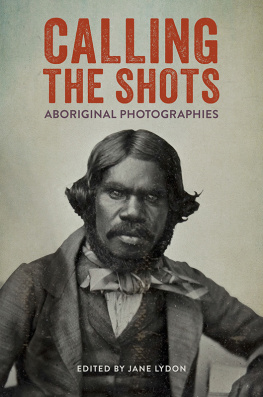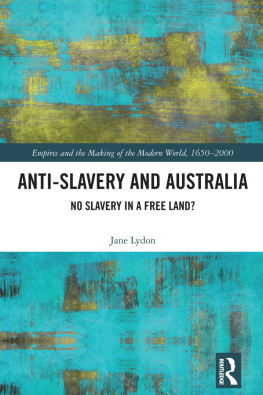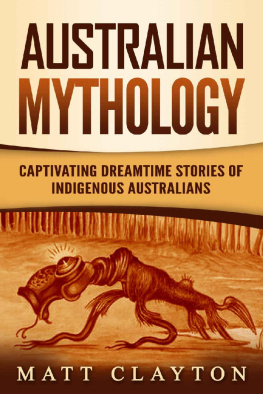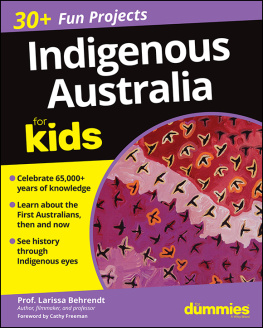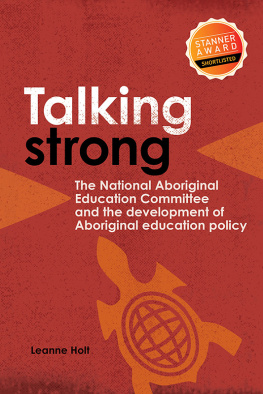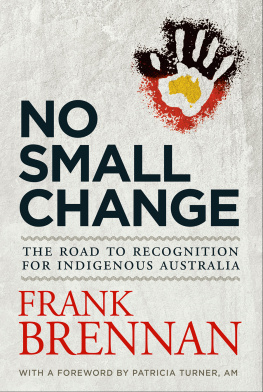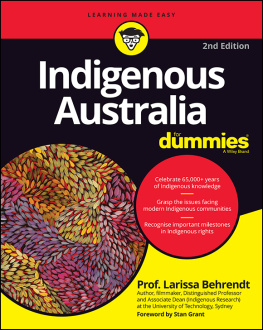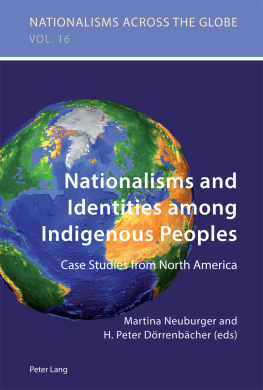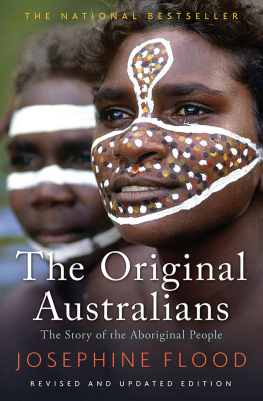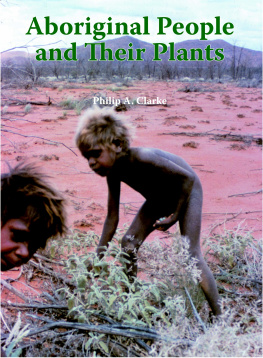The extraordinary photographs depicted throughout this book Calling the Shots: Aboriginal Photographies touch on the beauty and trauma of Aboriginal lives. From Eastern Arnhem Land to western New South Wales and beyond, the depiction of Aboriginal people from early frontier and settler times to the present day is at once confronting, and then positively liberating! Those who have worked with such conflicting and inspirational photographic archives know the bittersweet pill of how we ask the questions: should we remember, do we want to remember, and how do we make this happen? There is no real fast or true rule for all. But in Lydons book, there is a way-finder.
Calling the Shots: Aboriginal Photographies cohesive netting of diverse community stories and images parallel international modes of documentation. Australias own trauma-scape can sit alongside the photographic evidence of the victims of Second World War, Pol Pot, and the disappeared of Chile and Argentina.
This inspirational book recalls personal and institutional histories and custodianship, collaborations and family passions that keep alive the memories that were systematically eradicated, divided or documented for the global currency of science, romance, fascination and tourism. The photographic evidence of the mostly nameless people originally photographed for nostalgia, is re-visited, re-expressed and re-positioned to re-divert the gaze.
The breath of fresh air in Calling the Shots: Aboriginal Photographies is the inclusion of historical research of diverse photographic documentary histories told by strong Indigenous voices that provide a curative to the dominant western historical narrative.
Energised by Lydons book, we should come together and speak about our histories through photographs, no matter how far and wide we are from our families today, no matter how difficult; it reminds us that we can keep alive important histories and make action for healing, inspiration and cultural-worth. This book allows us to unpack, re-piece and juxtapose divergent photographic stories about how and why photographs of Aboriginal people were made and kept.
Read on and see, feel and share the unravellingthere has been change in the air, and it just got crisper.
Brook Andrew, Artist
Calling the Shots is a welcome intervention into an emerging literature on photographies other histories, an exciting work for those interested in photographic history, visual culture, decolonized history, and indigeneity. The volume draws on remarkable archives of images made of and at times by Indigenous Australians; in all cases, these archives are being reclaimed by those whose images were taken. Readers are invited to reflect with the authors a robust combination of Indigenous and non-indigenous scholars on a wide range of work, from the earliest photographic encounters on the continent only two years after the invention of the medium, to more recent collections emerging from family archives and Aboriginal cultural activists. In short, this collection brings us the richness of rarely seen images and rarely heard Indigenous Australian perspectives on photography that engages their past, present, and future with great insight and sensitivity.
Professor Faye Ginsburg, New York University, Director, Center for Media, Culture and History
CALLING THE SHOTS
ABORIGINAL PHOTOGRAPHIES
EDITED BY JANE LYDON
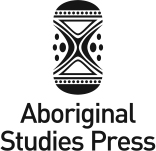
First published in 2014 by Aboriginal Studies Press
Jane Lydon in the collection, 2014
in individual chapters is held by the contributors, 2014
All rights reserved. No part of this book may be reproduced or transmitted in any form or by any means, electronic or mechanical, including photocopying, recording or by any information storage and retrieval system, without prior permission in writing from the publisher. The Australian Copyright Act 1968 (the Act) allows a maximum of one chapter or 10 per cent of this book, whichever is the greater, to be photocopied by any educational institution for its education purposes provided that the educational institution (or body that administers it) has given a remuneration notice to Copyright Agency Limited (CAL) under the Act.
Aboriginal Studies Press is the publishing arm of the Australian Institute of Aboriginal and Torres Strait Islander Studies.
GPO Box 553, Canberra, ACT 2601
Phone: (61 2) 6246 1183
Fax: (61 2) 6261 4288
Email:
Web: www.aiatsis.gov.au/asp/about.html
National Library of Australia Cataloguing-in-Publication
Title: Calling the shots: aboriginal photographies/Jane Lydon, editor and contributor; contributors, Julie Gough, Sari Braithwaite, Shauna Bostock-Smith, Lawrence Bamblett, Michael Aird, Karen Hughes, Aunty Ellen Trevorrow, Donna Oxenham, Laurie Baymarrwangga and Bentley James.
ISBN: 9781922059598 (paperback)
9781922059604 (ebook:pdf)
9781922059611 (ebook:epub)
9781922059628 (ebook:Kindle)
Notes: Includes index.
Subjects: Aboriginal AustraliansAustraliaHistoryPictorial works. Aboriginal Australians Social life and customsPictorial works. Families, Aboriginal AustralianPictorial works.
Other Authors/Contributors: Lydon, Jane, 1965 editor. Gough, Julie, 1965. Braithwaite, Sari. Bostock-Smith, Shauna. Bamblett, Lawrence. Aird, Michael, 1963. Hughes, Karen Elizabeth. Trevorrow, Ellen. Oxenham, Donna. Baymarrwangga, Laurie. James, Bentley.
Dewey Number: 305.899150994
Front cover: Aboriginal man of Poonindie. Ambrotype. With the permission of Special Collections, University of Bristol Library, Papers of Mathew Blagden Hale, DM130/239.
CONTENTS
Jane Lydon
Julie Gough
Jane Lydon and Sari Braithwaite with Shauna Bostock-Smith
Lawrence Bamblett
Jane Lydon
Michael Aird
Jane Lydon and Sari Braithwaite
Karen Hughes and Aunty Ellen Trevorrow
Donna Oxenham
Jane Lydon and Sari Braithwaite
Laurie Baymarrwangga, Bentley James and Jane Lydon
ACKNOWLEDGMENTS
This book was funded by a four-year Australian Research Council Discovery Project, titled Aboriginal Visual Histories, which explored the role of the camera in mediating colonial exchange and incorporated Indigenous perspectives through collaboration with descendants. We thank several researchers for the Aboriginal Visual Histories project between 2008 and 2011, especially Tom Gara for research in South Australia and Sue Stanton for the Northern Territory. Their careful archival research helps form the basis for further work presented here as introductory histories. As co-Chief Investigator, Lynette Russell was a supportive colleague throughout the project. We also thank Rhonda Black of Aboriginal Studies Press for her encouragement and patience. Sari Braithwaite and Megan McKeough obtained image permissions. Many colleagues and friends have provided advice and encouragement throughout the project and we are grateful to them all.
We are grateful to the many institutions and individuals who generously gave us permission to reproduce their photographs, also acknowledged within each separate chapter. We thank the Allport Library and Museum of Fine Arts; the Thomson family and the Museum of Victoria; Bill Nicholson and the Wurundjeri Tribe Land Cultural Heritage Council Inc.; Loraine Padgham, Angela Tenbuuren and the Taungurong; the Tasmanian Museum and Art Gallery; the Trustees of the British Museum; Ronald Briggs and the Mitchell Library at the State Library of New South Wales; the National Library of Australia; Christopher Morton and the Pitt Rivers Museum, Oxford; Les Simon of the Batemans Bay Local Aboriginal Land Council; Tharawal Land Council; Jude McBean and the Grafton Regional Gallery; the Northern Territory Library; Sarah Morgan; Zena Cumpston; Isobel Crombie, Jennie Moloney and Maggie Finch at the National Gallery of Australia; La Trobe Picture Collection at the State Library of Victoria; Gary Murray for the Yung Balug and Dhudhuroa clans; the Dja Dja Wurrung Clans Aboriginal Corporation; Michael Treloar; Doris Yuke Collection; John Oxley Library of the State Library of Queensland; Paul Costigan; Queensland Art Gallery; University of Queensland Anthropology Museum; Queensland Museum; South Australian Museum; Ellen and Tom Trevorrow; Walter Richards; Cynthia Hutchison and the Ngaut Ngaut Mannum Aboriginal Community Association; Ayers House Collection, Adelaide; Jamie Carstairs and Hannah Lowery of the Special Collections, University of Bristol Library; Jackie Johnston and the Mill Cottage Museum Collection, Port Lincoln; State Library of South Australia; State Library of Western Australia; Berndt Museum; Northern Territory Library; National Archives of Australia; Ara Irititja; Royal Geographical Society of South Australia; the Elders of Billiluna Pastoral Company; Jill Braithwaite; and Ian Conway.
Next page
